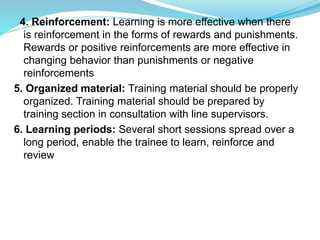Tarining evaluation
- 2. HUMAN RESOURCE MANAGEMENT SEMINAR ON TRAINING OF EMPLOYEES TOPIC: TRAINING EVALUATION BY, RAHUL.C.R Roll no:14
- 3. Introduction The purpose of evaluating training is to help with future decisions about the organizations training program. Using evaluation, the organization may identify a need to modify the training and gain information about the kinds of changes needed. The organization may decide to expand on successful areas of training and cut back on training that has not delivered significant benefits.
- 4. Principles of Training 1. Clear objectives: The objectives and scope of training should be clearly defined. A comparison of operational requirements and existing human resource skill will help to determine the specific training needs of employees 2. Training policy: Such a policy should specify who is responsible for training, what is to be spent in training etc. 3. Motivation: Employees tend to be more responsive to training programs when they feel the need to learn.
- 5. 4. Reinforcement: Learning is more effective when there is reinforcement in the forms of rewards and punishments. Rewards or positive reinforcements are more effective in changing behavior than punishments or negative reinforcements 5. Organized material: Training material should be properly organized. Training material should be prepared by training section in consultation with line supervisors. 6. Learning periods: Several short sessions spread over a long period, enable the trainee to learn, reinforce and review
- 6. 7. Preparing the instructor: The instructor or trainer is the key figure in a training program. 8. Feedback: Trainees should be provide information on how much they have learnt and how well they are doing. 9. Practice: Practice makes man perfect. Skills that are practiced often are better learned and less easily forgotten. Therefore, trainees should be allowed continuous practice. 10. Appropriate techniques: The methods and processes of training should be related directly to the needs and objectives of the organization.
- 7. Need for Evaluating Training Effectiveness It is necessary to evaluate the extent to which training programmers have achieved the aims for which they were designed. Such an evaluation would provide useful information about the effectiveness of training as well as about the design of future training programs. Evaluation enables an organization to monitor the training program and also to update or modify in future programs of training.
- 8. Types of evaluation Evaluating the Training addresses how one determines whether the goals or objectives were met and what impact the training had on actual performance on the job. 1. Formative evaluation provides ongoing feedback to the curriculum designers and developers to ensure that what is being created really meets the needs of the intended audience. 2. Process evaluation provides information about what occurs during training. This includes giving and receiving verbal feedback. 3. Outcome evaluation determines whether or not the desired results (e.g., what participants are doing) of applying new skills were Achieved in the short-term. 4. Impact evaluation determines how the results of the training affect the strategic goal.
- 9. : Levels of Training Evaluation Level1: evaluate reactions. Did the trainees like the program, the trainers, the facilities? Did they think the course was useful? What improvement can they suggest? Distribute and analyze questionnaire Level2: evaluate learning To what extent do trainees have greater knowledge or skills after the training program than they did before? Administrator Written tests Performance tests Simulations tests
- 10. Level3:evaluate behavior Are trainees behaving differently on the job after training? Are they using skills and knowledge they learned in training? Collect performance data from Superior Peer Client subordinate • profits
- 11. Level4: evaluating results Is the organization or unit better because of training? Measure Accidents Quality Productivity Turnover Morale Costs
- 13. Methods of Evaluation Several methods can be employed to collect data on the outcomes of training. Some of these are: The opinions and judgments of trainers, superiors and peers. Asking the trainees to fill up evaluation forms Using a questionnaire to know the reactions of trainees Giving oral and written tests to trainees to ascertain how far they learnt, Arranging structured interviews with the trainees Comparing trainees performance on-the-job before and after training Studying profiles and career developments charts of trainees Measuring levels of productivity, wastage, costs, absenteeism’s and employee turnover after training Trainees comments and reactions during the training period, and Cost benefit analysis of the training program Feedback: After the evaluation, the situation should be analyzed to identify the possible causes for a difference between the expected outcomes and actual outcomes.
- 14. Conclusion For organization to achieve the best from training and development initiates there must be deeper understanding on the need for training evaluation. It is the responsibility of the organization to constantly carry evaluates the training programs and techniques implemented so as to establish how effective and efficient it is for both the organization and the individual.















